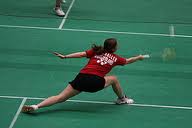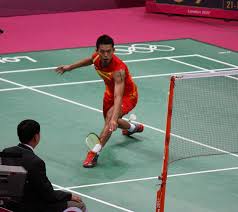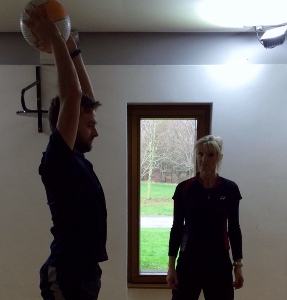Main Menu
Latest Blog Entry
User login
How to get fit for Badminton: Learning from 3 of the best
Should you use badminton for fitness?
 Badminton is recommended as a way of getting fit by the NHS for the general population. However, it is an intermittent explosive sport of random patterns of play. This entails risk.
Badminton is recommended as a way of getting fit by the NHS for the general population. However, it is an intermittent explosive sport of random patterns of play. This entails risk.
Whilst skill level will automatically mean that there is a lot of bending down and picking up the shuttlecock for beginners, it is important to know how to get fit to play badminton too.
As skill level improves and the game speeds up, badminton players need to be able to cope with the increased demands on the body. At a higher level, increased fitness will help you gain an edge over your opponents, and keep you healthy to practice more.
Duncan has put together some detail here in 2 parts:
- The demands of the game (quite technical).
- Ways to get fit (practical tips).
We have also asked 3 Badminton experts: Andy Wood, Julie Bradbury and Krysten Coombs, for their advice and insights into what this means in practical terms.
Badminton rule changes affect the fitness requirements
Badminton can be played in doubles or singles format; the format influences the style of play and physiological demands. Rule changes implemented in 2006 were designed to make the game more exciting.
Traditionally matches were the best of 3 sets, to 15 for doubles and mens’ and to 11 for women. You could win a point only on your serve and would then get a 60-second rest between games and at either 8 or 6 points in a third game.
Andy Wood (ex Performance Director for Badminton GB) says “Over the last decade the World Badminton Federation (WBF) has been experimenting with the scoring system in order to make the game more commercially viable.“
 Matches are now the best of 3 sets to 21 for all formats, you win a point when you win a rally. When the first team reaches 11 points both teams get a 60-second rest, then between games, both teams get a 2-minute rest.
Matches are now the best of 3 sets to 21 for all formats, you win a point when you win a rally. When the first team reaches 11 points both teams get a 60-second rest, then between games, both teams get a 2-minute rest.
Julie Bradbury (pictured), a former GB representative in Barcelona & Atlanta Olympics, who still competes for England in the Masters series says “the game has become more attacking since the rule change as you can win on every point.“
Physiological demands:
Singles matches are slightly slower but you need to be able to cover the entire court multiple times during a rally, (shown in the table below) with an average point lasting 6-8 seconds.
Table 1: shows % of rallies at their respective length in time (seconds) with deviation in brackets, from traditional 15 or 11 point format games.
|
Rally Length |
Mens Singles |
Womens Singles |
Mens Doubles |
Womens Doubles |
|
<2 seconds |
4.29 (2.69) |
1.88 (3.25) |
27.65 (3.49) |
16.42 (3.44) |
|
2-4 seconds |
20.87 (3.7) |
29.37 (10.53) |
26.42 (6.02) |
22.57 (4.34) |
|
4-8 seconds |
30.83 (3.32) |
39.75 (4.47) |
21.28 (3.64) |
28.73 (8.28) |
|
8-16 seconds |
30.62 (4) |
25.47 (8.15) |
15.46 (4.07) |
22.28 (5.11) |
|
>16 seconds |
13.17 (2.8) |
3.79 (3.85) |
9.02 (4.72) |
10.11 (5.48) |
Doubles matches are much faster and have shorter rally lengths, shown in the table by the distribution of rally lengths being 2-6 seconds.
Brodie Miller (England U15 representative in 2011) says “you need to be fitter for singles matches because the mixed doubles tactics mean the female player stays at the front of the court to utilise the male’s strength from the back.”
A study in 2005 used time-motion analysis to breakdown the demands on players.
Table 2 shows demands based on a sample size of 14 singles matches played in the traditional format.
|
Mean |
Max |
Min |
|
|
Max Heart Rate |
190.57 |
201 |
186 |
|
Average Heart Rate |
173.43 |
187 |
162 |
|
Total Time (seconds) |
1689.33 |
2308 |
1320 |
|
Playing Time (seconds) |
548.75 |
696 |
387 |
|
Performance Time (seconds) |
6.4 |
8.86 |
4.57 |
|
Rest Time (Seconds) |
12.93 |
18.7 |
9.2 |
|
No. Rallies |
83.22 |
99 |
64 |
|
No. Shots |
510.75 |
774 |
354 |
The results are based on the traditional format so only limited information can be taken from them. What we can take from them is how hard the player works, working at near maximal heart rate with a work to rest ratio of 1:2
Andy Wood says “There is a massive variability in the length of rallies according to playing levels. This makes the game so fascinating. The players have to make the most of their fitness resource, working on aerobic and anaerobic fitness. They then have to find a way to utilise it within the game”.
Mechanical loading on the body
 Badminton requires the athlete to control movements at varying velocities and through a full range of motion. If the movements are uncontrolled you will be off-balance and out of position resulting in losing points.
Badminton requires the athlete to control movements at varying velocities and through a full range of motion. If the movements are uncontrolled you will be off-balance and out of position resulting in losing points.
Multi-directional lunges are the main movement performed during a match. In singles, this could be several steps covering the court before lunging, whereas in doubles fewer steps are required but quicker reactions especially if you are the front player.
These movements are performed dynamically using the Stretch Shortening Cycle (SSC), this is where the muscle goes from an eccentric contraction (stretch) to a concentric contraction (shortening) rapidly.
The video below shows how to add variety to your lunge training and therefore help create more resilient badminton players.
Common Injuries
Badminton is one side dominant, many shots are played on the forehand, players look to move across the backhand to use their stronger forehand if they can to keep the pressure on opponents.
The dynamic change of directions can result in sprained ankles and the repeated plyometric movements can result in Achilles tendonitis, patella tendonitis and potentially stress fractures.
With the one-sided nature leading to muscle asymmetries, rotator cuff injuries and postural issues are also frequent.
“Players are much better prepared physically and have better education & support now compared to in the past,” says Julie Bradbury.
“Training occasionally involved working with Korean coaches, aimed more towards mental toughness compared to athletic development, and conditioning was self-led outside of badminton training“.
How to improve your badminton fitness
There are 2 main aspects to getting fit for badminton: your engine and your wheels. You can have a brilliant engine (work capacity), but without the wheel (movement control and resilience) to get you there, you will break down.
 To control the movement we need to practice the movement. Movements occur in all 3 planes (sagittal, frontal & transverse) so we need to train like that.
To control the movement we need to practice the movement. Movements occur in all 3 planes (sagittal, frontal & transverse) so we need to train like that.
Start by training simple movements and then progress to complex movements.
5 simple movements with progressions to complex:
|
Simple |
Complex |
|
Lunge |
Single leg squat |
|
Lateral Lunge |
Multi directional lunge |
|
Plank |
Sit through |
|
Single leg balance |
Single leg balance & reach |
|
Press Up |
Walk out Press up |
By improving strength through range of movement you can help reduce the number of injuries. Adding these exercises to a daily routine or warm up will help prepare your body for the stresses placed upon it by the sport.
An example of exercise progressions for the trunk and shoulders can be seen here:
With many players training several times a week and playing at weekends by adding extra plyometric work could increase the chances of overuse injuries unless carefully monitored.
Improving work capacity
You can use training to help improve work capacity, by manipulating training, adding rules to make points last longer, you can make points last longer than matches while working at different intensities.
|
Type of game |
% max heart rate |
Work: rest ratio |
|
Medium intensity |
85% |
1: 0.5-1 |
|
High Intensity |
85-95% |
1: 1-1.5 |
|
Maximal intensity |
95+% |
1: 1.5-3 |

Krysten Coombs
We use rope skipping and short shuttle runs as alternatives to just playing badminton. The shuttle runs are preferable to straight line running as they work on change of direction too.
Krysten Coombs who in the recent BWF World Para Badminton Championships came 2nd in the Doubles and Quarter-finals in the Singles
“Fitness in Para Badminton is really important as rallies usually last 15/20 shots with little time to recover in between.
It’s even more important in the Dwarf game as we are limbs are a lot shorter which means we have to cover twice as much distance as everyone else!“
A great example in the Dwarf game is that you will often see players diving because they just need that extra bit of movement they don’t have. (James has been working with Krysten for 6 years and has included specific exercises for this reason).
Summary
Badminton players are required to play at high intensities and work in all 3 planes of movement. Badminton fitness training should start with working on control of movement progressing to quicker more complex movements which will help reduce injuries and improve performance.
Be aware that warming up is important: whatever your level ! Especially if you have been sat down at a desk, or driven to the venue.
Further reading:
Client Testimonials
 David Lloyd Tennis Academy
David Lloyd Tennis Academy
James is much liked and respected by all the players both because of his wide knowledge of tennis specific fitness and his ability to communicate the content.
More


Comments
[…] Elkin, a badminton Coach, said “Some people improve because they enjoy it some people enjoy it because they […]
[…] How to get fit for Badminton, 3 experts offer their advice and experience. Includes how the game has changed over the last 10 […]
[…] How to get fit for badminton Duncan Buckmaster and I look at lessons learnt from working with top Badminton players. An analysis of the fitness requirements and how new rules changes have affected this. […]